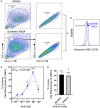A New E-Series Resolvin: RvE4 Stereochemistry and Function in Efferocytosis of Inflammation-Resolution
- PMID: 33643307
- PMCID: PMC7902526
- DOI: 10.3389/fimmu.2020.631319
A New E-Series Resolvin: RvE4 Stereochemistry and Function in Efferocytosis of Inflammation-Resolution
Abstract
The resolution of the acute inflammatory response is governed by phagocytes actively clearing apoptotic cells and pathogens. Biosynthesis of the specialized pro-resolving mediators (SPMs) is pivotal in the resolution of inflammation via their roles in innate immune cells. Resolvin E4 (RvE4: 5S,15S-dihydroxy-eicosapentaenoic acid) is a newly uncovered member of the E-series resolvins biosynthesized from eicosapentaenoic acid (EPA) recently elucidated in physiologic hypoxia. This new resolvin was termed RvE4 given its ability to increase efferocytosis of apoptotic cells by macrophages. Herein, we report on the total organic synthesis of RvE4 confirming its unique structure, complete stereochemistry assignment and function. This synthetic RvE4 matched the physical properties of biogenic RvE4 material, i.e. ultra-violet (UV) absorbance, chromatographic behavior, and tandem mass spectrometry (MS2) fragmentation, as well as bioactivity. We confirmed RvE4 potent responses with human M2 macrophage efferocytosis of human apoptotic neutrophils and senescent red blood cells. Together, these results provide direct evidence for the assignment of the complete stereochemistry of RvE4 as 5S,15S-dihydroxy-6E,8Z,11Z,13E,17Z-eicosapentaenoic acid and its bioactions in human phagocyte response.
Keywords: M2 macrophages; eicosapentaenoic acid; lipid mediator; omega-3 fatty acids; phagocytes; pro-resolving; pro-resolving mediator.
Copyright © 2021 Libreros, Shay, Nshimiyimana, Fichtner, Martin, Wourms and Serhan.
Conflict of interest statement
The authors declare that the research was conducted in the absence of any commercial or financial relationships that could be construed as a potential conflict of interest.
Figures






Similar articles
-
E-series resolvin metabolome, biosynthesis and critical role of stereochemistry of specialized pro-resolving mediators (SPMs) in inflammation-resolution: Preparing SPMs for long COVID-19, human clinical trials, and targeted precision nutrition.Semin Immunol. 2022 Jan;59:101597. doi: 10.1016/j.smim.2022.101597. Epub 2022 Feb 16. Semin Immunol. 2022. PMID: 35227568 Free PMC article. Review.
-
Metabolization of Resolvin E4 by ω-Oxidation in Human Neutrophils: Synthesis and Biological Evaluation of 20-Hydroxy-Resolvin E4 (20-OH-RvE4).ACS Pharmacol Transl Sci. 2023 Nov 20;6(12):1898-1908. doi: 10.1021/acsptsci.3c00201. eCollection 2023 Dec 8. ACS Pharmacol Transl Sci. 2023. PMID: 38093843 Free PMC article.
-
15-epi-lipoxin A5 promotes neutrophil exit from exudates for clearance by splenic macrophages.FASEB J. 2024 Jul 31;38(14):e23807. doi: 10.1096/fj.202400610R. FASEB J. 2024. PMID: 38989570 Free PMC article.
-
Resolution metabolomes activated by hypoxic environment.Sci Adv. 2019 Oct 23;5(10):eaax4895. doi: 10.1126/sciadv.aax4895. eCollection 2019 Oct. Sci Adv. 2019. PMID: 31681846 Free PMC article.
-
Recent advances in the chemistry and biology of anti-inflammatory and specialized pro-resolving mediators biosynthesized from n-3 docosapentaenoic acid.Bioorg Med Chem Lett. 2017 Jun 1;27(11):2259-2266. doi: 10.1016/j.bmcl.2017.03.079. Epub 2017 Mar 31. Bioorg Med Chem Lett. 2017. PMID: 28408222 Review.
Cited by
-
E-series resolvin metabolome, biosynthesis and critical role of stereochemistry of specialized pro-resolving mediators (SPMs) in inflammation-resolution: Preparing SPMs for long COVID-19, human clinical trials, and targeted precision nutrition.Semin Immunol. 2022 Jan;59:101597. doi: 10.1016/j.smim.2022.101597. Epub 2022 Feb 16. Semin Immunol. 2022. PMID: 35227568 Free PMC article. Review.
-
Role of Specialized Pro-Resolving Mediators in Modifying Host Defense and Decreasing Bacterial Virulence.Molecules. 2021 Nov 18;26(22):6970. doi: 10.3390/molecules26226970. Molecules. 2021. PMID: 34834062 Free PMC article. Review.
-
The Role of Innate Immunity and Bioactive Lipid Mediators in COVID-19 and Influenza.Front Physiol. 2021 Jul 22;12:688946. doi: 10.3389/fphys.2021.688946. eCollection 2021. Front Physiol. 2021. PMID: 34366882 Free PMC article. Review.
-
Polyunsaturated Fatty Acids: Conversion to Lipid Mediators, Roles in Inflammatory Diseases and Dietary Sources.Int J Mol Sci. 2023 May 16;24(10):8838. doi: 10.3390/ijms24108838. Int J Mol Sci. 2023. PMID: 37240183 Free PMC article. Review.
-
Polyunsaturated fatty acids and fatty acid-derived lipid mediators: Recent advances in the understanding of their biosynthesis, structures, and functions.Prog Lipid Res. 2022 Apr;86:101165. doi: 10.1016/j.plipres.2022.101165. Epub 2022 May 1. Prog Lipid Res. 2022. PMID: 35508275 Free PMC article. Review.
References
Publication types
MeSH terms
Substances
Grants and funding
LinkOut - more resources
Full Text Sources
Other Literature Sources
Research Materials

